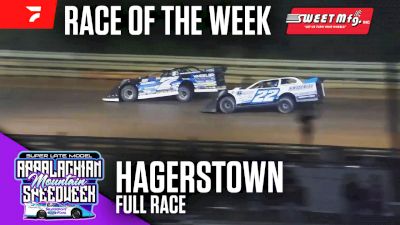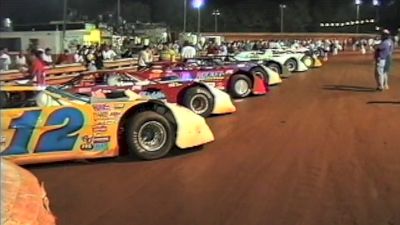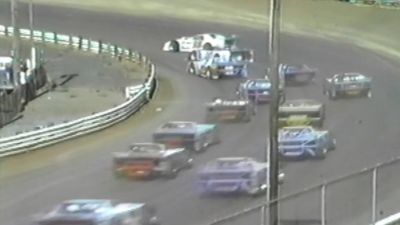How 'Old-School Hagerstown' Still Puts On Great Half-Mile Racing
How 'Old-School Hagerstown' Still Puts On Great Half-Mile Racing
Hagerstown Speedway shows that Dirt Late Models can still shine on half-mile ovals where aerodynamics play a significant role.

- Auto
- 1080
- 720
- 480
- 360
- 136
Gregg Satterlee skipped competing in Eldora Speedway’s Dream XXX in Rossburg, Ohio, over the weekend because he just couldn’t miss racing at his favorite racetrack, Hagerstown Speedway.
The historic half-mile at the intersection of I-70 and I-81 will forever hold a special place in the former national touring regular’s heart. Sunday’s Appalachian Mountain Speedweek victory where he upended race-long leader Tyler Emory rounding for the white flag — a victory from the 10th starting spot — added to Satterlee’s adoration.
“It’s right there at the very top,” Satterlee said of his love for the Hub City oval. “I don’t know, it’s just I’ve had lots and lots of success here. (My crew chief) Robby (Allen has) lived in Hagerstown. He’s raced there his whole life with different cars. It seems like we can do lots of different stuff in different track conditions. It seems to always fit something. It’s also, for the most part, pretty racy.
“But yeah, it’s right up there with Port Royal and Lernerville, tracks I grew up racing. It’s right at the top.”
The night had been nostalgic not only for Satterlee, but for competitors and onlookers alike. Eventual sixth-place finisher Matt Cosner and ninth-finishing Jason Covert both called Sunday “old-school Hagerstown” where Covert describes “one end (in turns one and two) was black slick and the other end was traction” thanks to the trees keeping shade over turns three and four of the racetrack as the sun goes down.
“It had the brown stripe around the bottom, too,” added Covert, a good friend to Satterlee. “Guys like Gary (Stuhler) and Rick (Eckert) could hug that bottom and catch that traction. Us guys who are chargers, we’d blow right through it. Then the track a few years later, it got browner. Us guys who can charge, we could charge in there in the middle, drive to the top, and come back off. Tonight, I felt like it had both times in it. It was good. The feature racing was really good. It was a lot of fun.”
Hagerstown’s timeless ability to put on quality, multigroove racing is proof that Dirt Late Models can still shine on half-mile ovals where aerodynamics play a significant role.
It’s just, in the words of Trever Feathers, who gained 17 positions in 45 combined laps (eighth-to-third in his heat race and 15th-to-third in the main event), said “it takes a certain racetrack” to get what Hagerstown produced Sunday.
“If there wasn’t a mud ring around the bottom, we’d all cut right through the middle,” said Feathers, who then emphasized “the biggest thing” behind mastering a place like Hagerstown is “racing the Gary Stuhler line of hugging the inside guardrail, and if (drivers) make one little mistake, you’re there to capitalize.
“I’ve followed Gary Stuhler enough that I know how to run the bottom,” Feathers added. “I felt like those guys were screwing up in the corners and would leave enough to get my nose in. Stuhler busted my ass a couple times like that. So it was nice to bust some people’s asses in the process of it. Yeah, when you follow Gary Stuhler around enough at Hagerstown, he teaches you a few things, as long as you’re paying attention.”
WATCH: STARS Late Models put on a show during 1996's Conococheague 100 at Hagerstown Speedway.
Even Covert, whose car wasn’t quite good enough to follow either Satterlee around the top nor Feathers around the bottom, still savored Sunday’s old-school vibe because Super Late Model races just don’t compete at Hagerstown as much as they did years ago (the track hosts four Super Late Model events in 2024).
“This is what I remember coming here trying to break into the Super Late Models,” Covert added. “I know the rhythm (of this place). I just couldn’t do it tonight. Congratulations to Gregg. I just love coming here. It’s like going to Path Valley on Tuesday. But I love Hagerstown. It’s tradition. I love it.”
While Covert calls it old-school Hagerstown, Satterlee would rather say that Sunday's ideal conditions is just Hagerstown in essence, no matter the past or present.
“I’d say old-school Hagerstown has a cushion on both ends and maybe is a little wetter on the top. I mean, to me, that’s just Hagerstown right there,” Satterlee said. “It gets black-slick top to bottom and gets to where you can move around and try to make time on cars. I felt the track was really good.”
What did it for Satterlee on Sunday is his flip of a switch going from fifth on the final restart with 12 laps left to the lead right before the white flag.
With multiple grooves, the fastest way around the half-mile came down to preference. For Satterlee, those ahead of him — Emory, Drake Troutman, Cosner and Feathers, in that order — darted low, so he hung his car out wide and found enough windows.
“Any time that lane is available, you can go faster, even though there’s not a lot of traction out there,” Satterlee said. “You can maintain. Late in those races, it’s hard to slow down and get going again (when racing along the bottom).”
Sunday's race was reminiscent of Satterlee’s epic last-lap pass of Scott Bloomquist in 2016 for his maiden Lucas Oil Late Model Dirt Series victory. It’ll probably stand as the most memorable moment of his career as long as Satterlee lives.

- Auto
WATCH: Relive one of the greatest Lucas Oil Dirt Late Model Series finishes of all-time at Hagerstown Speedway.
“Probably that, and the first time we won at Eldora,” Satterlee said. “That was definitely one of the bigger wins. (The Eldora victory) wasn’t a Saturday night event, but it was cool to go on the stage there.
“When I passed Scott, I drove literally right past him. He slid a little wide and I went beneath him and drove right by him, like he had the brakes on or something. It was ridiculous. I remember when I did it I was like, ‘Holy s--- I’m fast.’ It caught me off guard. Tonight I had to slide Emory. … It worked out.”
While the final restart with 12 laps remaining turned the tide for Satterlee, it left Cosner rather perplexed. Before the stoppage, Cosner tracked down Emory on a 14-lap green-flag run. Then on the restart, he backslid from second to sixth, claiming he couldn’t keep his tires cool enough.
“Not taking anything away from those two (Satterlee and Feathers) … but I thought we were going to pass those two guys at the end,” Cosner said.
“But you had the old-school (Hagerstown) with the brown ring right around the inside guardrail leaving turn four, all the way down the inside guardrail in the straightaway. (Cars were) washing out, guys being able to roll the corner through the slick, and Gregg is really, really good here in those conditions. Old-school Hagerstown, obviously.”
The strongest takeaway from Sunday, whether performance or postrace assessment, had been from Feathers, the Winchester, Va., driver who used a decade-old Team Zero race car and engine in his charge toward the front. He had to park his primary car — the blue and black No. 20 — after time trials and switch to his backup — the red and gold No. 27 — which is primary steel-block car.
He changed engines, of course, but the technology on the night’s backup car was not as up to date as his nearest competitors.
Feathers for once felt like Sunday’s racing surface neutralized the field and put more control into the drivers’ hands without technology pigeonholing race teams, especially Weekend Warriors limited on resources. And he has a strong message to share after Sunday.
“That’s the product of the body of these cars,” Feathers said. “Tyler (Emory) was struggling there at the end and Satterlee still had to banzai him to pass him. That’s the racing we’re in. Until these higher-ups get their heads out of their asses, we have to change something with this racing. Our racing, yeah, it’s awesome once the leader catches lapped traffic. After that … last night when you watch Eldora and literally anywhere, the leader drives off in clean air. They need to do something so we can race.”
Veteran Jeff Rine said before Sunday’s action that today’s Dirt Late Model racing is “basically like the IROC Series from back in the day," comparing Dirt Late Models to the identically-prepared cars because “everybody has a good engine, everybody has a good car, everybody has good shocks” and “the times are so close.”
“It’s kind of crazy,” Rine said. “It’s so hard anymore to be competitive.”
For the first time in more than two decades, the 47-year-old Rine is no longer racing two nights a week. This year he’s expanded his racing with the Tim Elbin-owned No. 92 team after his No. 2J team folded over the winter. Car owner Kathleen Kurtz sold Rine’s No. 2J equipment mainly because “things hadn’t been the same since” since her husband, Jeff Kurtz, died November 2022 but also because the sport’s rising costs.
Feathers himself has scaled back his Super Late Model racing program slightly this year and purchased a steel-block engine because of the following concerns.
“We all don’t have million-dollar budgets. We all don’t have 15 cars and 10 motors,” Feathers said. “Hopefully somebody can do something soon with these cars. I know they started cracking down on the noses, the width of the noses. And, please, square up these damn bodies. That is killing our racing.
“People who say this is the best racing they’ve ever seen, that’s a load of crap. Go back and watch races from the 1980s and '90s and 2000s here. The racing was unbelievable.”
WATCH: Memorable Late Model highlights from 1988's Springfest at Hagerstown Speedway.
The kind of racing that’d leave an impression on a competitor and spectator is exactly what miniseries organizer Jim Bernheisel took away from Sunday, too. And why he’s gone to great measures to revive and continue building up the miniseries.
“It made it like it used to be here when I raced here, shoot, 30 years ago,” Bernheisel said. “Sometimes it doesn’t lend itself to good racing, but it did (Sunday). There were a lot of movers, comers and goers — guys’ tires firing and some fading — which is cool because of the racing stripes tire program.
“That’s the kind of stuff that attracted me to racing as a young kid. That just makes it way cool. … We had a nice crowd here tonight. I’d like to see the crowds grow. That’s why we’re doing this. We have a good program here. And not just us. This region and racing and tracks we go to, go support them. This is how this keeps happening.”

